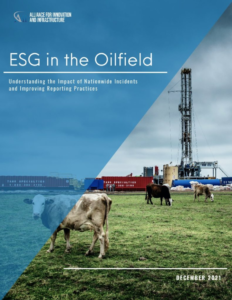 Running ahead of public policy, the corporate world is adopting new and innovative ways to ensure responsible operations and stewardship of their environments. The approach of environmental, social, and corporate governance (ESG) has given companies a framework to prioritize projects, minimize their footprint, engage their communities, and measure their performance for shareholders, as well as consumers and the public.
Running ahead of public policy, the corporate world is adopting new and innovative ways to ensure responsible operations and stewardship of their environments. The approach of environmental, social, and corporate governance (ESG) has given companies a framework to prioritize projects, minimize their footprint, engage their communities, and measure their performance for shareholders, as well as consumers and the public.
Within the energy industry, approaches to ESG differ from the broader corporate world. For the oil and gas sector, ESG means practical and grounded actions aimed at responsibly developing natural resources, minimizing releases of hazardous material, and safeguarding surrounding farm and ranchland. Assessing current activity and charting the path forward requires performance and incident data from the exploration and production (E&P) sector of the industry.
While performance is traditionally measured through oil and gas volumes extracted and safely transported, an ESG framework calls for higher standards and nuanced impact evaluation. For this reason, we must assess oil and gas, as well as wastewater byproduct handled at and near the well pad and carried across sensitive agricultural land.
To evaluate and understand ESG in the oilfield, we must understand the relative rate of incidents, the volumes released, and the underlying root causes. This must be data-driven and analyzed independently of regulatory or industry interests. Available data shows that produced water is generated in volumes vastly surpassing valuable product, possesses higher potency and risk of environmental damage, and spills at higher rates and volumes than marketable hydrocarbons. Evaluating the treatment and focus on produced water relative to oil and gas reveals that ESG within the industry is missing an important element. Grounded ESG must incorporate produced water and waste management, while continuing its strong existing focus on oil and gas.
A survey of oil and gas producing states reveals two sets challenges and solutions to bring about improved ESG. These both implicate data availability and material investments.
Challenges
• Data: Only seven states require spills of produced water to be reported, and often treat it less stringently than valuable hydrocarbons. Limited access to public data on incident rates and volumes hinders needed insights for improvement and targeted investment.
• Materials: From limited available data, produced water incident rates and spill volumes regularly surpass the volumes of marketable oil and gas. The identifiable root causes across all products are equipment failure, material issues (e.g. corrosion), and human error.
Solutions
• Data: As the industry seeks to improve its ESG and better self-regulate, access to more and better-quality data is essential. Forming or contributing to a voluntary reporting database on incident rates and volumes that details root causes will provide individual companies and the industry the insights it needs to further drive down incidents and improve operations.
• Materials: With available incident data and internal analysis, companies can begin to invest in better products and equipment with more resilient materials that are less susceptible to corrosion and other common issues in production lines, tanks, and other facilities.
> Read the feature in Hart Energy
Written by Benjamin Dierker, Director of Public Policy
The Alliance for Innovation and Infrastructure (Aii) is an independent, national research and educational organization. An innovative think tank, Aii explores the intersection of economics, law, and public policy in the areas of climate, damage prevention, energy, infrastructure, innovation, technology, and transportation.